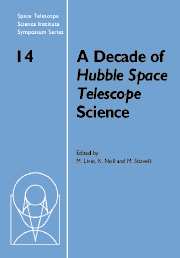Book contents
- Frontmatter
- Contents
- Participants
- Preface
- HST studies of Mars
- HST images of Jupiter's UV aurora
- Star formation
- SN1987A: The birth of a supernova remnant
- Globular clusters: The view from HST
- Ultraviolet absorption line studies of the Galactic interstellar medium with the Goddard High Resolution Spectrograph
- HST's view of the center of the Milky Way galaxy
- Stellar populations in dwarf galaxies: A review of the contribution of HST to our understanding of the nearby universe
- The formation of star clusters
- Starburst galaxies observed with the Hubble Space Telescope
- Supermassive black holes
- The HST Key Project to measure the Hubble Constant
- H0 from Type Ia supernovae
- Strong gravitational lensing: Cosmology from angles and redshifts
HST images of Jupiter's UV aurora
Published online by Cambridge University Press: 13 August 2009
- Frontmatter
- Contents
- Participants
- Preface
- HST studies of Mars
- HST images of Jupiter's UV aurora
- Star formation
- SN1987A: The birth of a supernova remnant
- Globular clusters: The view from HST
- Ultraviolet absorption line studies of the Galactic interstellar medium with the Goddard High Resolution Spectrograph
- HST's view of the center of the Milky Way galaxy
- Stellar populations in dwarf galaxies: A review of the contribution of HST to our understanding of the nearby universe
- The formation of star clusters
- Starburst galaxies observed with the Hubble Space Telescope
- Supermassive black holes
- The HST Key Project to measure the Hubble Constant
- H0 from Type Ia supernovae
- Strong gravitational lensing: Cosmology from angles and redshifts
Summary
One of the brightest and most variable UV emissions in the solar system comes from Jupiter's UV aurora. The auroras have been imaged with each camera on HST, starting with the pre-COSTAR FOC and continuing with increasing sensitivity to the present with STIS. This paper presents a short overview of the scientific results on Jupiter's aurora obtained from HST UV images and spectra, plus a short discussion of Saturn's aurora.
The Earth's aurora: Present understanding
With a long history of ground-based and spacecraft measurements, we now have some understanding of the physics of the Earth's auroral processes. A general picture of the nature of auroral activity on the Earth has evolved, without a complete understanding of the many details. In general, auroral emissions are produced by high energy charged particles precipitating into the Earth's upper atmosphere from the magnetosphere (the region of space where the motions of particles are governed by the Earth's magnetic field). It is well established that the Earth's auroral activity is related to solar activity, and more specifically to conditions in the solar wind reaching the Earth. The precipitating charged particles are accelerated to high energies in the Earth's magnetosphere, with some acceleration occurring in the magnetotail region and some occurring by fieldaligned potentials in the topside ionosphere.
- Type
- Chapter
- Information
- A Decade of Hubble Space Telescope Science , pp. 25 - 43Publisher: Cambridge University PressPrint publication year: 2003



